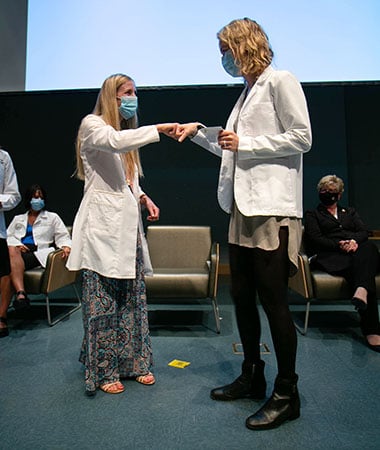“What is the significance of the White Coat Ceremony for advanced practice registered nursing students?”
That’s the question University of Colorado College of Nursing Associate Professor and Interim Assistant Dean of Master’s Programs Krista Estes, DNP, FNP-BC, Professor of Clinical Teaching and Associate Dean of Clinical and Community Affairs Rosario Medina, PhD, FNP-BC, ACNP, CNS, FAANP, Glenda Robertson, MA, RN, and Professor and Assistant Dean of CU Nursing’s PhD Program Jacqueline Jones, PhD, RGN, tried to answer.
What they found was that the ceremony was overwhelmingly positive.

CU Nursing faculty and APRN student fist bump in celebration at the CU College of Nursing 2021 White Coat Ceremony |
They looked at CU Nursing’s first White Coat Ceremony (WCC) for APRN students for a program evaluation published in the Journal of the American Association of Nurse Practitioners. It was an in-person ceremony and reception held in September 2021. CU Nursing already has several traditions for nursing students, including a Call to Care Ceremony (formerly known as a Nightingale Ceremony), when the college decided to incorporate at WCC.
“The college used the WCC to mark another momentous transition: completion of all milestones necessary to enter graduate programs and demarcation of the point when new graduate students begin preparing for the advanced practice registered nurse (APRN) role, certified nurse practitioner (CNP), certified nurse midwife (CNM) and clinical nurse specialist (CNS),” the authors wrote. “The intent was to add cachet/value to the academic experience and reinforce the profundity of this career choice for students.”
Evaluating CU Nursing’s WCC
Columbia University’s Vagelos College of Physicians and Surgeons held the first white coat ceremony in 1993. A professor wanted to inaugurate a medical school education with a ceremony highlighting humanism in medicine. WCCs started for nursing programs in 2013. Now, 410 colleges of nursing in all 50 states offer WCCs.
“The WCC has generally been adopted by nursing programs as a student ’rite of passage’, taking place at the start of matriculation and welcoming students in the healthcare profession,” the authors wrote.
The 39 people who attended CU Nursing’s ceremony (students, staff, and faculty) were sent a survey to give feedback about the event. Responses were received by 33 people, with the majority being APRN students.
History of White Coat Ceremonies |
|
Physicians wore black garments up until the late 1800s to represent the formality of the profession, but some took the color to signify death. White clothing began to symbolize cleanliness and purity once aseptic techniques became common.
In the 20th century, the white coat became a symbol of trusted authority, but the authors say a white coat can also represent a power imbalance, citing hierarchies, social and economic privilege of physicians, and breaching the public trust through science experiments (such as the U.S. Public Health Service Syphilis Study at Tuskegee).
“Some studies have suggested that just seeing a white coat can raise the blood pressure of some patients, causing ’white coat hypertension’,” the authors say. “Institutions that hold WCCs must recognize our society’s complex relationship symbol with the white coat.” |
The responses found 85% of the attendees considered the WCC “important” or “very important”. Thirty people felt the ceremony welcomed them to the APRN program, was a rite of passage into the program, and provided a personal sense of achievement and professionalism.
The authors found four main WCC-inspired themes from survey responses: recognition, transition, symbolism, and connection. Here are some survey responses describing each theme:
- Recognition: “honoring the profession of APRNs”, “great to involve their (a student’s) support system”, “a challenging but sacred undertaking”
- Transition: “rite of passage”, “marking an expansion and dedication to a new phase of the profession”, “milestone achievement”
- Symbolism: “the white coat was a symbol that everyone recognizes and respects”, “a reminder of the devotion of the advanced practice nursing to patient care”
- Connection: “a way to bring together cohorts and faculty members”, a “touchpoint to get together with students and engage with them in a meaningful way”
The authors note that CU Nursing’s WCC was limited by pandemic-related policies and procedures. Those procedures included things like restrictions on how many people could attend and a two-week notice of the event. They also say some students wanted to receive their white coat after they had been in the program longer, so they could have already formed relationships with faculty.
“As this tradition gains traction and builds longevity, it will require continued attention to, and continued modification of, what the ceremony promotes intentionally/unintentionally and what the ceremony means to our students, patients, and communities,” the authors wrote.

